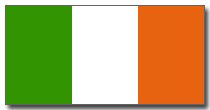
Flag of Ireland
Irish History - Culture
What makes the Irish people unique? Is it their sense of humor? Their beautiful Gaelic language? The numerous myths and legends that have been passed down from generation to generation? It is true that over the centuries, the Irish people have suffered immense hardship through wars, famine and forced immigration. Irish soldiers were sent all over the world to fight the battles of other countries, their people were thrown out of their homes by English landlords and forced to 'Hell or to Connaught'. Families were separated and sold as slaves to the highest bidder! How is it that the Irish have kept their immense sense of pride? How do Irish eyes keep smiling? The ancestors of Irish descendants today suffered severe hardship but their religious beliefs and love of their native land has resulted in a race of extremely strong willed people who have over the years proved they were prepared to die for their country rather than submit to becoming just another part of England. The country of Ireland has a long and often painful history.
Irish History - Potato Famine
The great potato famine also known as the potato blight reached its peak in Ireland in 1847 and has a huge impact on the history of Ireland. It caused death and mass emigration mainly to America. The famine of the 1840's was not the first potato famine in Irish history, the Famine of 1741 and 1822 both also killed hundreds of thousands of Irish people who relied on the potato as their main food source. Read about the Famine or Coffin Ships and the fate of the Irish people who travelled on them in search of a better life.
Irish History - The Flag Of Ireland
The flag of Ireland is more commonly known as the 'Tricolor' and it has three equal vertical bands of Green (hoist side), White and Orange. It is the national flag of the Republic of Ireland or Eire and was made official in 1937 when the Constitution of Ireland was adopted. Each of the three colors has a symbolic meaning. Click here to read about the different flags of Ireland and Northern Ireland and how the flags have changed throughout history.
Irish History - The Book of Kells
The Book of Kells is an amazing 9th Century manuscript also sometimes called the Book of Columba. The illustrated book is deeply symbolic to the Celtic people and to the history of this wonderful country. It contains illustrations of the four Gospels and was written in Latin. We have included a selection of images from this historic illuminated manuscript.
Irish History - The War In Ireland
Irish soldiers fought in the battles of numerous other countries from the Thirty Years War fought across Europe to the American Civil War as well as the battles they fought in their own country against British rule. Read about the different conflicts that occurred in Ireland over the centuries that helped to shape its history.
England was determined for Ireland to become part of England but the Irish people refused to give in to English rule despite huge human losses over the centuries. Their determination eventually paid off but it was not until April 1949 that the majority of the island of Ireland became a Republic after the Republic Act of 1948 was passed (passed on 21 December 1948, effective from 18 April 1949). This act also removed the constitutional status of the British Monarchs and passed the responsibility onto the Irish President who became a full head of state. Northern Ireland remains part of the United Kingdom.
An 18th Century Signal Tower built to guard against attack from
the French during the Napoleonic War at Crohy Head, Co Donegal
Irish History - Facts
Read a selection of facts about Ireland and its history. We have included a huge selection of interesting and historical facts as well as witty and funny facts, a great way to learn about Ireland and its people in a succinct way. A great study aid and an ideal way to brush up on your Irish trivia in advance of your next pub or table quiz, a great fun way to learn factual and accurate information about Ireland.